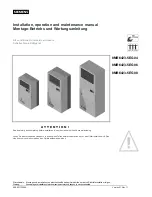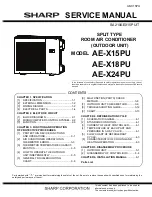
2
ONLY individuals meeting the requirements of an
“Entry Level Technician”, at a minimum, as specified
by the
may use this information. Attempting
to install or repair this unit without such background
may result in product damage, personal injury, or
death.
Air Conditioning, Heating and Refrigeration
Institute (AHRI)
Important Note to the Owner regarding Prod-
uct Warranty
Your warranty certificate is supplied as a separate document
with the unit installed by your contractor. Read the limited war-
ranty certificate carefully to determine what is and is not cov-
ered and keep the warranty certificate in a safe place. If you
are unable to locate the warranty certificate please contact
your installing contractor or contact customer service (877-
254-4729) to obtain a copy.
Shipping Inspection
Always keep the unit upright; laying the unit on its side or top
may cause equipment damage. Shipping damage, and subse-
quent investigation is the responsibility of the carrier. Verify
the model number, specifications, electrical characteristics,
and accessories are correct prior to installation. The distribu-
tor or manufacturer will not accept claims from dealers for trans-
portation damage or installation of incorrectly shipped units.
Codes & Regulations
This product is designed and manufactured to comply with
national codes. Installation in accordance with such codes and/
or prevailing local codes/regulations is the responsibility of the
installer. The manufacturer assumes no responsibility for equip-
ment installed in violation of any codes or regulations.
The United States Environmental Protection Agency (EPA)
has issued various regulations regarding the introduc-
tion and disposal of refrigerants. Failure to follow these
regulations may harm the environment and can lead to
the imposition of substantial fines.
Should you have any
questions please contact the local office of the EPA.
If replacing a condensing unit or air handler, the system must
be manufacturer approved and Air Conditioning, Heating and
Refrigeration Institute (AHRI) matched.
NOTE:
Installation of
unmatched systems is strongly discouraged.
Operating the unit in a structure that is not complete (either as
part of new construction or renovation) will void the warranty.
Installation Clearances
Special consideration must be given to location of the con-
densing unit(s) in regard to structures, obstructions, other units,
and any/all other factors that may interfere with air circulation.
Where possible, the top of the unit should be completely unob-
structed; however, if vertical conditions require placement be-
neath an obstruction
there should be a minimum of 60
inches between the top of the unit and the obstruction(s).
The specified dimensions meet requirements for air circulation
only. Consult all appropriate regulatory codes prior to deter-
mining final clearances.
Another important consideration in selecting a location for the
unit(s) is the angle to obstructions. Either side adjacent the
valves can be placed toward the structure provided the side
away from the structure maintains minimum service clearance.
Corner installations are strongly discouraged.
OK!
OK!
AA
AA
A
A
C
C
C
C
OK!
OK!
OK!
OK!
NOT
RECOMMENDED
AA
AA
AA
AA
AA
B
B
B
B
Model Type
A
B
C
AA
Residential
10"
10"
18"
20"
Light Commercial
12"
12"
18"
24"
Minimum Airflow Clearance
This unit can be located at ground floor level or on flat roofs. At
ground floor level, the unit must be on a solid, level foundation
that will not shift or settle. To reduce the possibility of sound
transmission, the foundation slab should not be in contact with
or be an integral part of the building foundation. Ensure the
foundation is sufficient to support the unit. A concrete slab
raised above ground level provides a suitable base.
Rooftop Installations
If it is necessary to install this unit on a roof structure, ensure
the roof structure can support the weight and that proper con-
sideration is given to the weather-tight integrity of the roof. Since
the unit can vibrate during operation, sound vibration transmis-
sion should be considered when installing the unit. Vibration
absorbing pads or springs can be installed between the con-
densing unit legs or frame and the roof mounting assembly to
reduce noise vibration.
Safe Refrigerant Handling
While these items will not cover every conceivable situation,
they should serve as a useful guide.
To avoid possible injury, explosion or death, practice
safe handling of refrigerants.
WARNING






























